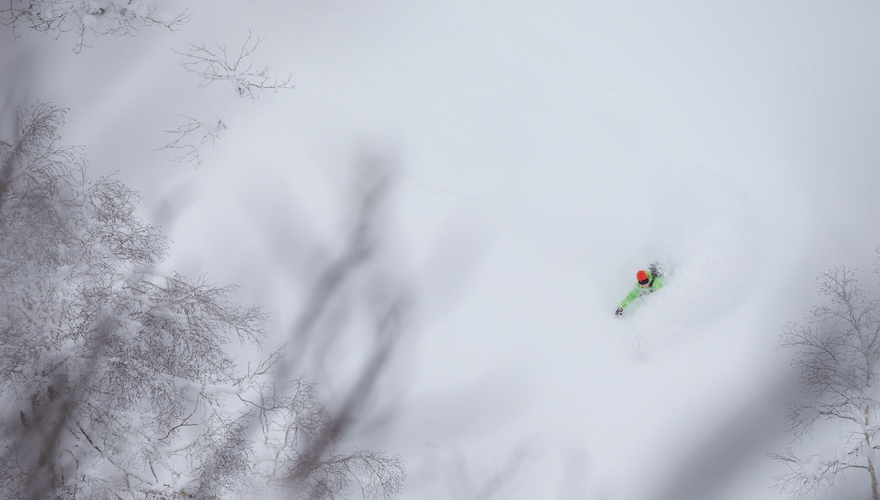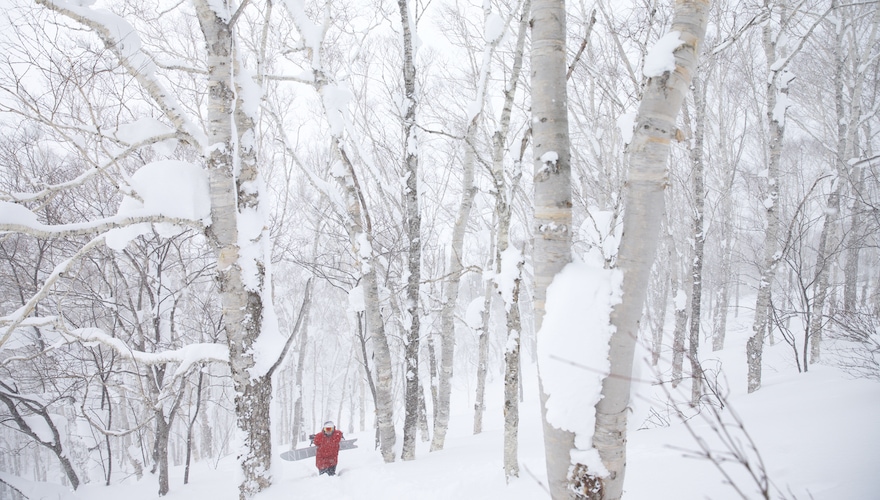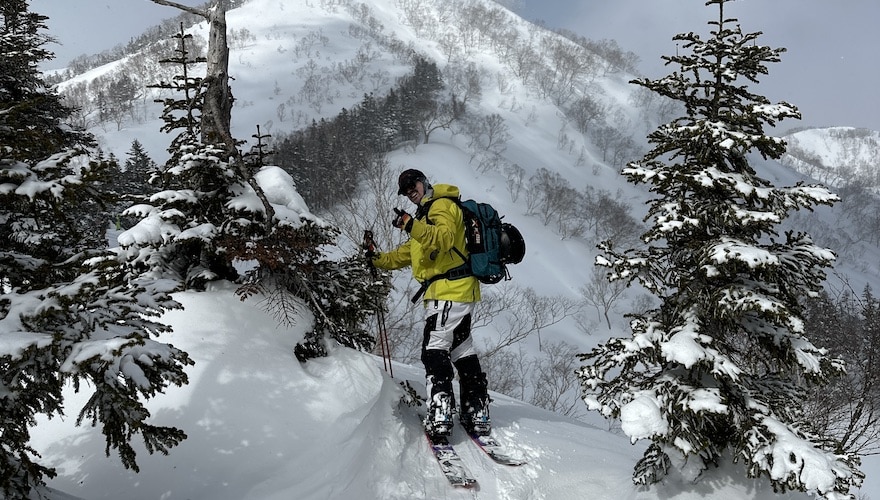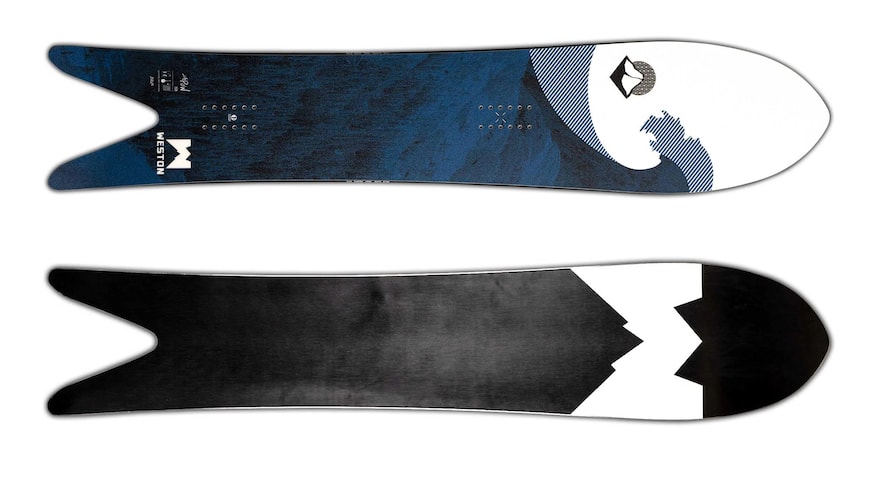Snowboarding in Japan has long been regarded as the pinnacle experience for most freeriders. It is known as the snowiest place on Earth, and its epic snow covers fantastic surfy terrain, attracting snowboarders worldwide.
Snowboarding Japan also offers a unique cultural experience, combining age-old tradition with the contemporary and a touch of the bizarre. When you add welcoming Japanese hospitality, a trip to the land of the rising sun could be the once-in-a-lifetime experience your looking for.
In this post, we will highlight what makes Japan an incredible destination for snowboarders. We will also tell you about the best time to snowboard Japan and how to enjoy a trip there in the best ways possible. Let’s get into it!
Why Japan Is An Amazing Destination For Snowboarding
For snowboarders, the main attraction for a snowboard trip to Japan are the reports of how much snow covers its mountains. You could be forgiven for thinking that the amount of snow that falls in Japan is exaggerated, but we can confirm that upwards of 600 inches (1524 cm) of snow can fall every year.
Japan gets so much snow due to chilly Siberian winds that collect moisture from the sea of Japan. This sea air rises to high altitudes and slams into the mountains, which is why Japanese ski resorts are famous for huge dumps of snow.
Japan is made up of thousands of islands. Still, most of the landmass lies within the main four, Honshu, Hokkaido, Kyushu, and Shikoku. You’ll find that Honshu and Hokkaido get all the snow, so most skiers and snowboarders need to head to these regions to enjoy the fabled Japow!
Best Time To Snowboard In Japan

Your Japanese snowboarding experience is greatly influenced by the time of winter you visit. Picking the best time to snowboard in Japan is essential or you could get skunked with poor snow conditions.
If you are familiar with the North American and European winter season, there shouldn’t be too many surprises. This is because the season in Japan starts in November and runs to the beginning of April. The national holidays are somewhat different, so you should research what’s going on to avoid the higher prices if you can. Let’s run through the Japanese winter season, so you can decide when the best time to go for you is:
December
Like Europe and North America, early December is hit-and-miss in Japan regarding snow coverage. Therefore accommodation prices will be lower. But if there has been some snow, the backcountry terrain may be a bit sketchy, so watch out for trees, bamboo (sasa) and rocks when hunting for fresh tracks.
Unsurprisingly, accommodation prices increase over Christmas and New Year, as this is a popular time for Japanese skiers and snowboarders to head to the mountains.
January
January is generally the coldest time of the year which means a visit at this time should provide you with fantastic dry snow conditions. The downside of visiting Japanese ski resorts in January is that they are often crowded. But that doesn’t mean you shouldn’t go in January because you can join a guided Japan backcountry tour that will take you away from the crowds to powder heaven.
The thing about having all this powder covering the mountains is that you of course need snow storms. In Japan, snow storms can be brutal, often closing roads and limiting visibility. It is entirely possible that the sun doesn’t show up for weeks at a time.
February
February is often a sweet spot for snowboarding in Japan. The snow quality is excellent, but the slopes are much quieter, while accommodation prices tend to be more reasonable. The only exception is that Japanese ski resorts become busier and more expensive during the Chinese New Year.

March
April
As you can see, your Japanese snowboarding experience can vary dramatically depending on when you go. So it would be best to consider what you want from your trip to ensure you get what you want from your visit. But in our experience, mid-January through February is the best time for snowboarding in Japan.
Backcountry Snowboard Trips to Japan
One of the best ways to experience Japanese powder for a snowboarder is on a splitboard. Splitboards allow snowboarders to get away from crowds and earn their turns. Yes, you have to put in lots of effort to hike into the mountains, but this is all part of the experience. You get to see the local terrain in a different way while planning your lines so you can get the best out of each run. Now imagine doing this in some of the deepest snow in the world!
This is why we have put together three fantastic Japanese backcountry trips tailored to ski tourers and splitboarders. These trips consist of small groups guided by professionals who know the terrain like the backs of their gloved hands. Our highly qualified guides will take you to powder-filled tree runs away from the crowds before heading into the stunning backcountry.
If you are an advanced snowboarder, you can join us for epic backcountry powder days while experiencing local culture. One of the great things about splitboarding in small groups is that there is more flexibility to adapt the itinerary to take advantage of the best conditions and terrain.
Here is a rundown of the three splitboard tours on offer:
Hakuba Tour - 6 days snowboarding the Japanese Alps
Hakuba is one of the best places to snowboard in Japan. In fact, it has a legendary status, thanks to the abundance of snow and epic terrain. Our Hakuba backcountry tours are fully hosted, meaning you can concentrate on enjoying riding in the backcountry, which is accessed via the lifts and on splitboards. Speaking of epic, if you have an Epic Pass you can save on this trip.
This week long guided trip is perfect for experienced riders. It is also based out of a comfortable hotel giving you easy access to Hakuba Village and everything it offers.

Hokkaido Tour - A week of deep powder chasing and tree riding
Hokkaido should be on your bucket list if you want to experience some of the world’s deepest snow. To make it easier for you, we have put together a backcountry-focused Hokkaido splitboard trip, but you also get to experience genuine Japanese culture.
To make the most out of this incredible destination, we base this trip from two locations, the historic seaport city of Otaru and the charming farming town of Furano. This means we have easy access to 8 fantastic ski resorts. Therefore there is plenty of scope for our certified guides to lead you to the best powder stashes the region has to offer.
Japanese Alps + Myoko Tour - 7 snowboarding days
The Japanese Alps and Myoko are home to some of the best places to snowboard in Japan. This is due to seemingly bottomless snow and fantastic terrain. But when you combine this with the cultural experience you only get from visiting this region, you have the recipe for the perfect Japanese backcountry snowboard trip.
Our guides will take you to the finest backcountry terrain in Myoko and Hakuba Valley by day. Hosting dinners on the town by night.
Best Places To Snowboard In Japan
We realize that a splitboarding or backcountry touring guided trip doesn’t suit every snowboarder. Many people just want to experience a Japan snowboarding trip without much effort- saving their energy for the downhill, which is understandable.
In our experience, Hakuba, Myoko, and Northern Honshu have some of the finest ski resorts suited to snowboarding. In fact, these areas offer some of the best snowboarding in Japan while giving you a genuine taste of Japan.
But which you choose depends on what you want to get out of your trip. For example, if you want a ski resort offering everything, head to Okushiga Kogen, Nozawa Onsen, or Myoko Kogen. However, if you want to focus your efforts on the best powder, you can’t go wrong with visiting Ani, Okushiga Kogen, or Geto Kogen.
At PowderQuest, we are big fans of the ski resorts in Hokkaido. Which is Japan’s northernmost island. Here, you can enjoy several world-class ski resorts. For example, Furano, in central Hokkaido, is well known for stellar landscapes and consistently good snow conditions. It is a good destination for mixed groups as there is suitable terrain for all skill levels. You can expect immaculately groomed slopes, beautiful tree runs, and epic power bowls.
Alternatively, you could visit Tomamu. This resort has a more contemporary style and is family-friendly. Whether you want to stay within the resort’s confines or head off-piste, Tomamu has it all.
Best Snowboard Type To Bring To Japan
To ensure you can make the most of snowboarding in Japan you will need the right tools for the job. By this, we mean you must bring the right snowboard for Japanese snow conditions. Of course, a decent all-mountain snowboard will be fine if you plan on staying in the resort. However, if you plan on heading into the backcountry, you will need something a little more powder-specific.

You’ll need a snowboard with a wide and long nose for snowboarding in Japan’s deep powder. This will keep the nose up out of the snow to prevent it from dipping under the snow. It also helps if the tail is narrower or has a swallowtail so the back of the board sinks.
When riding deep powder, there’s a good chance your back leg will ache after a while. Therefore for snowboarding in Japan, it is best to choose a snowboard that allows you to set the stance towards the tail of the board. This will reduce the effort you need to put in to keep your board’s nose out of the snow, reducing your fatigue.
A longer snowboard has more surface area, which increases float in powder. Therefore a slightly larger snowboard may benefit you if you want to stick with an all mountain style board. However, don’t go over the top with this, as a snowboard that is too big for you will be more challenging to ride. Especially in the tight trees of Japan. Always check the sizing guide and cross-reference it with your weight before you buy a powder snowboard. Don’t be shocked if you are suddenly riding a board that is 5-10 cm shorter than your regular snowboard.
FAQs & Tips
Q: Are English-speaking instructors and guides available at Japanese ski resorts?
A: Yes, many Japanese ski resorts have English-speaking instructors available. Popular resorts catering to international visitors often have many English-speaking instructors from Australia. However, checking with the specific resort or snowboard school in advance is a good idea to ensure availability. If hiring a guide, we highly recommend looking into their certifications. While there are hundreds of friendly riders claiming to be guides, you want to make sure you hire a professional guide when heading off-piste or into the backcountry.
Q: Do I need to bring my own snowboard, or can I rent one in Japan?
A: Both options are available. You can rent snowboard equipment in most Japanese ski resorts and local shops. Renting a snowboard or splitboard can be a convenient option, especially if you want to avoid buying a powder snowboard specifically for your trip. However, bringing your own is also a viable choice if you have specific preferences or are attached to your own setup that rips in powder and tight trees.
Q: What is the etiquette for riding in Japanese ski resorts?
A: Japanese ski resorts have specific guidelines and etiquette that riders are expected to follow. Like home, this includes respecting the lift queues, yielding to others when merging onto a slope, and avoiding stopping in the middle of the run. However somethings may be very different from home. You should be mindful of the local culture and be courteous to fellow riders and resort staff. For example: Talking while in a gondola or tram is frowned upon. Yep, the Japanese enjoy the silence, so try to embrace it.
Japanese Snowboarding From a Locals Perspective
If this beautiful film by Travis Rice featuring Nagano local and pro rider Shin Biyajima does not make you buy a plane ticket to shred powder in Japan right now, nothing will. Japanese snowboarding as an art.
